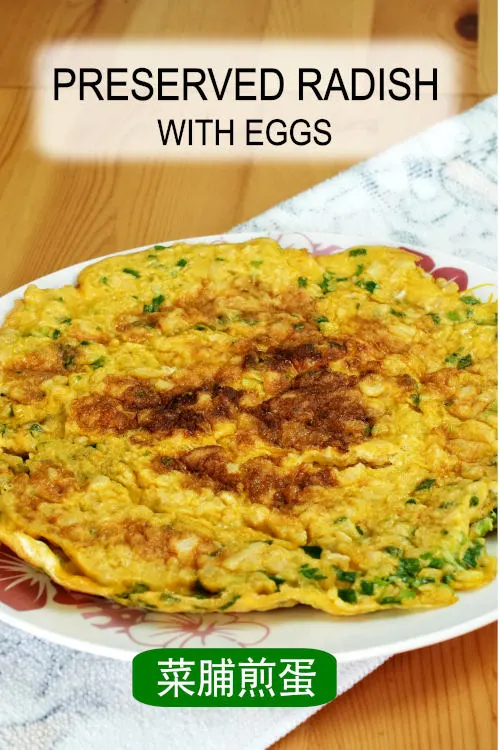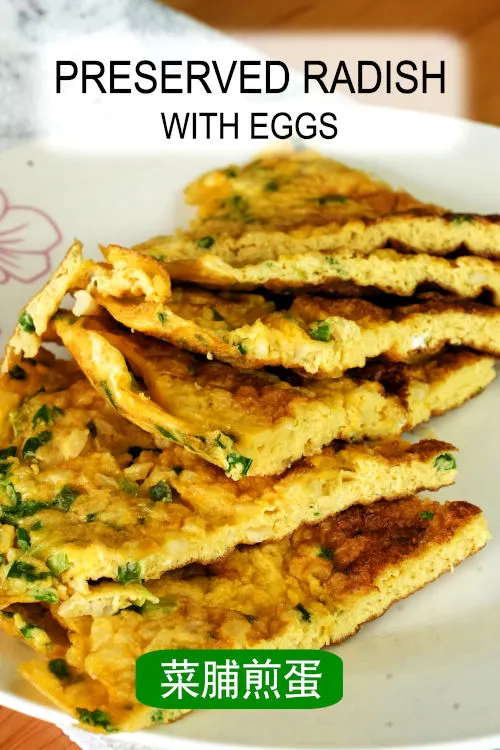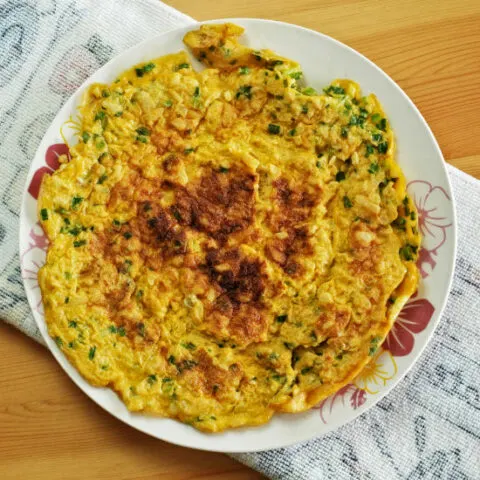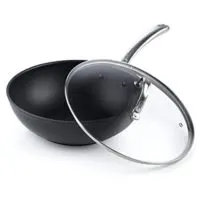Preserved radish with eggs, also known as 菜脯煎蛋 is a popular Chinese cuisine, especially among the Cantonese. This dish is an omelet seasoned with soy sauce and sugar flavored with preserved radish. The preserved vegetables give the dish a slightly tangy and salty taste, while the eggs provide a fluffy and mild texture that complements the overall flavor.
This dish is usually served alongside steamed rice.
I decided to make this dish for my lunch today since it is quick and easy, as I am dining alone. The eggs and the preserved radish are so flavorful that there is no need to add meat, and simple seasonings suffice.
Here is the step-by-step instruction on how to prepare the preserved radish with eggs.
Note: This post may contain affiliate links. Please read my privacy policy for more info. I may receive commissions for purchases made through links in this post. As an Amazon Associate, I earn from qualifying purchases.

What is preserved radish (菜脯 / chai poh)?
This preserved radish is a versatile ingredient that adds depth and complexity to many Chinese dishes, including stir-fries, noodle soups, and congee. With its slightly salty flavor and crunchy texture, it is a popular ingredient that provides a burst of flavor in every bite.
Its crunchy texture adds an extra dimension to dishes, making it a beloved ingredient among Chinese food enthusiasts.
Steps to prepare the preserved radish with eggs
- Crack the eggs into a mixing bowl and beat them until they are well mixed. Set aside.
- Rinse the preserved radish under running water, then soak it in water for ten minutes to remove the excess salt. After that, drain the excess water and chop them into small pieces.
- Place the chopped preserved vegetables in a dry pan without oil over low heat. Toast them slowly to remove the excess water. When they become dry and aromatic, remove them from the pan cool.
- Put the dried preserved vegetables and the chopped green onions into the beaten eggs.
- Season it with light soy sauce, sugar, and ground white pepper. Mix well.
- Heat the vegetable oil in a wok or a non-stick pan over medium-high heat.
- Pour the beaten egg mixture into the pan and reduce the heat. Use the chopstick to stir the egg mixture and spread it thinly gently. This step helps to ensure the egg is evenly cooked.
- When the first side has turned golden brown, flip the radish omelet to cook the other side.
- After both sides have turned golden, remove from heat and drizzle with sesame oil (optional) before serving.
Note
- Some variations of this dish also include diced vegetables such as bell peppers or carrots.
- You can adjust the amount of preserved turnips according to your taste preference.
- Do a taste test to check the saltiness of the preserved radish to decide if you need to add some salt or more light soy sauce.
- Some places make this dish with duck eggs, but the difference is unnoticeable.
- You may use fish sauce instead of light soy sauce for a change.
Other usages of preserved radish in Chinese cooking
Here are other ways to use preserved radish besides making the egg omelet.
- Stir-fries. Preserved radish can be added to stir-fried dishes such as stir-fried pork or noodles to add a savory flavor and crunchy texture.
- Soups. It can be added to the soup to enhance the flavor, such as in fish ball noodle soups and rice porridge (Teochew porridge)
- Dim sum. Preserved radish is the main ingredient for dim sums, such as radish cake (蘿蔔糕).
- Meat dishes. Its flavor complements all meat dishes. Please check our steamed ground pork with the preserved vegetable recipe.
You can purchase preserved radish in most Asian grocery stores, and some mainstream supermarkets may also carry it in their international food section. It is sold under various names, including pickled turnips, preserved turnips, or Chinese pickles. To ensure you get the right product, ask the storekeeper for assistance by showing them the Chinese word 菜脯.

What are other similar preserved vegetables similar to 菜脯?
Generalizing preserved radish as a typical Chinese preserved vegetable can be confusing, as there are various preserved vegetables with distinct flavors and uses. These vegetables vary based on the vegetable used, preparation method, and regional variation. Here is a brief overview of some commonly preserved Chinese vegetables. Remember to show the Chinese character to the storekeeper to ensure you purchase the types of preserved vegetables you want.
- In this recipe, we use 菜脯 (cài fǔ), commonly known as “preserved vegetable” or “pickled vegetable” in English. This type of preserved vegetable is made by salting, fermenting, and drying radish, resulting in a salty and slightly sweet taste with a crunchy texture.
- 冬菜 is made from fermented Chinese cabbage hearts (Northern China) or mustard (Sichuan). The cabbage is sun-dried and then cut into thin strips before being rubbed with salt and garlic and placed in earthenware pots to ferment. The resulting vegetable has a strong, intense flavor similar to sauerkraut and is infused with garlic taste. This type of preserved vegetable is often used in soups, stews, and stir-fries and can even be used to make an omelet.
- 梅菜 (Méi cài) is made from dried and salted mustard. To make it, mustard greens are pickled with salt, sugar, and spices, then fermented in the sun. This process produces a salty and slightly sweet flavor for stir-fries and steamed dishes.
- 榨菜 (zhà cài) is made by pickling and preserving a special kind of mustard cabbage from Sichuan, the Brassica juncea var. napiformis mustard. It is characterized by its salty and sour taste and is a popular ingredient in Sichuan cuisine.
- 酸菜 (suān cài) is made from fermented whole Chinese cabbage or mustard. It is made by pickling cabbage with salt and spices and then fermenting it in the sun. This gives it a sour and slightly salty taste, perfect for adding to hot pots, dumplings, soups, and stir-fries.
- 芽菜 (yá cài) (Sichuan pickled mustard greens) is a unique type of pickled mustard plant from Sichuan, made from the leaves of a local variety. The leaves are dried in the sun and then rubbed with salt before being layered with sugar in stoneware pots for months of fermentation. The resulting vegetable has a distinctive flavor that is fundamental to Sichuan cuisine.
- 榄菜 (Lǎn cài), a specialty of Cantonese cuisine, is a type of preserved vegetable made from olives and mustard leaf. The process involves pickling olives with salt, spices, and sometimes chili peppers before drying them in the sun or baking them in an oven. The resulting vegetable has a chewy texture and a salty, slightly sweet taste. It is commonly used as a condiment or ingredient in dishes such as congee and stir-fries.
You can get more information about the preserved vegetables here and here.
Other egg recipes
Here are some related recipes for you.
- Try this shrimp and egg recipe, another classic Cantonese home-cooked dish.
- Simple egg drop soup is one of the most popular Chinese soups worldwide.
- Find out how to prepare the silky smooth Chinese steamed eggs here.

Preserved radish with eggs
Preserved radish with eggs 菜脯煎蛋 is a quick and easy Chinese recipe. The pickled flavor and the delicate egg are a perfect match.
Ingredients
- 4 eggs
- 1 stalk green onion, cut into thin rings
- 2 tbsp of vegetable oil
- 40g of preserved radish, chopped finely
- 1/4 tsp of sugar (optional)
Instructions
- Crack the eggs into a bowl.
- Rinse the preserved radish under running water, then soak it in water for ten minutes to remove the excess salt. After that, drain the excess water and chop them into small pieces.
- To remove the excess water, toast the preserved vegetables in a dry pan without oil over low heat.
- Put the preserved vegetables and the chopped green onions into the beaten eggs.
- Season it with light soy sauce, sugar, and ground white pepper. Mix well.
- Heat the vegetable oil in a wok.
- Pour the beaten egg mixture into the pan and reduce the heat. Use the chopstick to stir the egg mixture and spread it thinly gently.
- When the first side has turned golden brown, flip the radish omelet to cook the other side.
- After both sides have turned golden, remove from heat and serve.
Recommended Products
As an Amazon Associate and member of other affiliate programs, I earn from qualifying purchases.
Nutrition Information:
Yield: 2 Serving Size: 1Amount Per Serving: Calories: 308Total Fat: 25gSaturated Fat: 4gTrans Fat: 0gUnsaturated Fat: 19gCholesterol: 372mgSodium: 702mgCarbohydrates: 6gFiber: 2gSugar: 2gProtein: 14g
This data was provided and calculated by Nutritionix on 27/3/2023



Lily Teh
Monday 27th of March 2023
Hi Mr Kwan, thank you for your recipe for the preserved radish with eggs. I am a bit confused - the 40g preserved vegetables and 40g preserved radish in the recipe are 2 different ingredients to be added to the eggs? one is choy poh (preserved radish) and the other is ..?
KP Kwan
Tuesday 28th of March 2023
Hi Lily, Thanks for pointing out the mistake. The preserved vegetable in the recipe is redundant and should not be there. I have corrected the recipe :)
KP Kwan
Monday 27th of March 2023
Hi, this is KP Kwan. I am happy to see you in this comment area, as you have read through my recipe. I am glad to reply to any questions and comments as soon as possible.